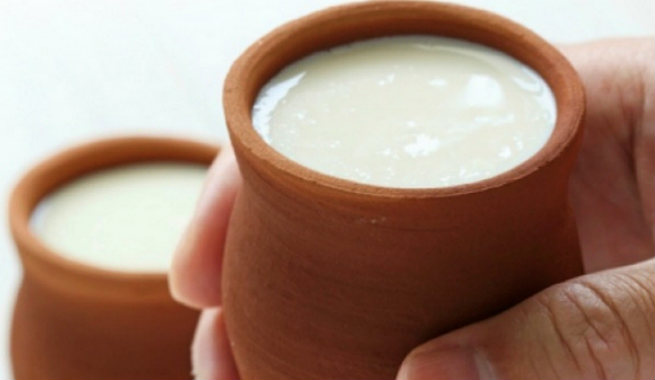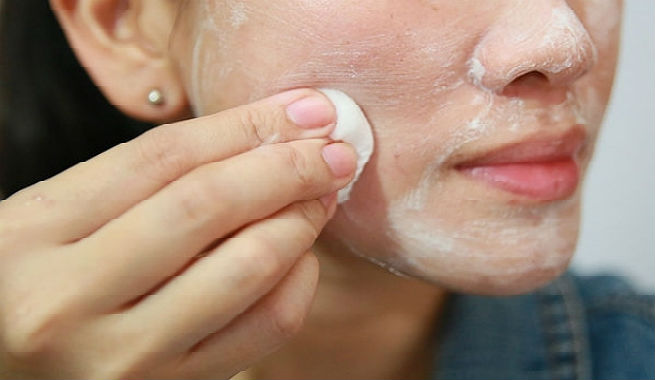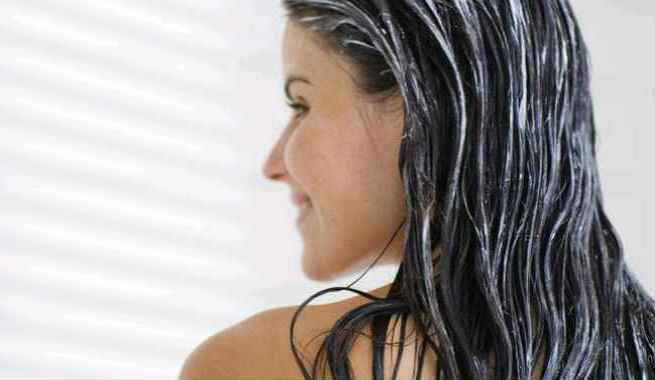Who does not love to enjoy a glass of buttermilk, especially in the scorching heat of the summer? The tasty and refreshing beverage is a favorite of all of us. But how many of you know that buttermilk is healthy, too? The delicious drink also comes with several beauty benefits. You can consume it directly or apply it topically, giving you excellent health and a stunning appearance. So today, we will explore different health, skin, and hair benefits of buttermilk along with its uses and drawbacks.
What is Buttermilk?
Buttermilk or chaas is a fermented dairy product that does not contain butter. Instead, we get the thick liquid leftover (thicker than milk) after churning whole milk into butter. While this traditional buttermilk is not readily available in Western countries, it is standard in Nepal, Pakistan, and India. However, the modern version of buttermilk is cultured by adding beneficial bacteria to the milk. According to ancient Ayurveda, buttermilk is an excellent natural remedy for our overall health and keeps several diseases (digestive disorders, lack of appetite, anemia, spleen maladies, swelling, etc.) away. Hence, it is considered a powerful natural alternative to almost all store-bought health drinks. The tangy flavor, refreshing nature, and cooling properties of buttermilk make it widely popular. The beverage also takes excellent care of our skin and hair from the inside out.
In India, buttermilk is used as a digestive staple. The taste and therapeutic benefits of the drink are even enhanced with dashes of spices like cumin powder, pepper powder, ginger powder, chopped green chilis, curry leaf powder, and crushed coriander leaves. Buttermilk is also used as a common ingredient in baked goods (breads, biscuits, muffins, pancakes, etc.), fries, soups, salads, and salad dressings.
Preparation of Buttermilk
The process of buttermilk preparation has gone through an evolution over the years. Earlier, unpasteurized buttercream was left to ferment by naturally occurring bacteria. This step before churning was known as ‘ripening.’ These days, however, only pasteurized and homogenized milk and cream are used to destroy the naturally occurring bacteria. So, ‘probiotics’ or the lactic-acid-producing bacteria cultures (Lactobacillus acidophilus or Lactobacillus bulgaricus) are added to the milk. The lactic acid produced by this bacteria reduces the pH level of buttermilk (4.4 – 4.8) and makes it more acidic. This curdles and thickens the milk by solidifying its primary protein, casein. As the milk sugar lactose ferments over time, the drink tastes slightly sour (1). Probiotics reintroduced in the process also keep unwanted bacterial growth at bay and increase the shelf life of the buttermilk.
Milk or cream used for preparing buttermilk can be of different types. Some of the most common choices are full cream, no cream, no fat, and mixed with water (half proportion). Each of them is known to have unique attributes as well as benefits.
Nutrition Profile of Buttermilk
A small serving of cultured buttermilk offers a lot of nutrition. According to the U.S. Department of Agriculture (USDA), a cup of the drink (245 ml.) contains 12 gm. of carbohydrate, eight gm. of protein, and three gm. of fat along with a wide range of vitamins (riboflavin, pantothenic acid, B12, D, etc.) and minerals (calcium, sodium, magnesium, potassium, iron, zinc, and phosphorus). It has only 98 calories, much less than whole milk (150 calories). However, buttermilk does not contain dietary fibers. (2)
Health Benefits of Buttermilk
Now, let us have a look at how sipping on some buttermilk can help our health:
1. Offers Enough Nutrition
Buttermilk comes packed with all essential nutrients and micronutrients. In other words, it is a ‘complete meal’ that can be consumed anytime, anywhere for a healthy, well-balanced diet. Hence, regular consumption of this nutritious drink is perfect for the human body and tissues.
2. Easy on the Digestive System
As lactic acid in cultured buttermilk breaks down its lactose content easily, people with lactose intolerance may find it a great food with no side effects (3). The drink is not only easy to digest but also aids in the process of digestion. Probiotics in buttermilk make it a perfect antidote for several gastrointestinal issues like bloating, irregular bowel movements, irritable bowel syndrome, stomach infections, and even colon cancer. It also helps better absorption of nutrients, thus taking care of our gastrointestinal health.
3. Reduces Body Heat
Buttermilk has a cooling effect on our digestive tract, significantly reducing overall body heat. In women, it helps in alleviating bothersome pre- and post-menopausal symptoms like hot flashes. People with a high metabolic rate and body temperature may also have buttermilk to counterbalance these.
4. Makes Bones Stronger
Rich in nutrients like calcium, phosphorous, etc., buttermilk is an essential building block for our skeletal frame. Full-fat varieties of buttermilk are also a good source of vitamin K2 (4). Some versions of the beverage come fortified with vitamin D, too. These nutrients may help strengthen bones and prevent degenerative diseases like osteoporosis (5). Studies have concluded that phosphorous in buttermilk increases bone mineral density (6), while vitamin K2 prevents bone breakdown and promotes new bone formation (7).
5. Lowers Blood Cholesterol
Buttermilk may help reduce total cholesterol (TC) and triglyceride levels in the bloodstream (8). It contains sphingolipid compounds (part of the milk fat globule membrane or MFGM), which inhibit the absorption of low-density lipoprotein (LDL) or bad cholesterol in the gut to a considerable extent.
6. Regulates Blood Pressure
An abundance of bioactive proteins in buttermilk helps keep blood pressure levels under check. Researchers suggest that the beverage decreases systolic and mean arterial blood pressure. It also reduces the plasma angiotensin-I converting enzyme level by regulating fluid volume in the body. (9)
7. Treats Ulcers Effectively
After a heavy and spicy meal, buttermilk soothes the irritated inner lining of the food pipe and the stomach by washing down oils and fats. Moreover, it keeps the acids from moving into the esophagus, preventing conditions like heartburn, acid reflux, GERD, etc. Buttermilk also acts as a natural therapy against stomach ulcers by neutralizing acids in the stomach.
Also Read – Homemade Body Butter Recipes To Change Your Skin Texture Forever!
8. Detoxifies the Body
The riboflavin or vitamin B2 content of buttermilk may help convert the ingested food to energy by activating enzymes in the body cells. In addition, it ensures the proper functioning of our liver, which is essential for detoxifying the body (10).
9. Boosts Immune System
Buttermilk may be highly effective in boosting our immune system with its lactic acid bacteria. As a result, we can stay away from various ailments caused by detrimental food pathogens. Consumption of it regularly may even help us ward off urinary tract infections and vaginal infections.
10. Protects from Dehydration
If you are struggling with dehydration, consider buttermilk as a natural remedy. More than 90% of the drink is water and electrolytes, which help maintain the body’s water balance by hydrating every cell efficiently.
11. Improves Oral Health
The anti-inflammatory properties of buttermilk may be effective in treating periodontitis, in which the soft tissues of the gum and the teeth-supporting bone structures get severely inflamed by periodontal bacteria (11). You can even enhance your overall oral health with the help of buttermilk by averting issues like oral thrush and mouth sores.
12. Controls Body Weight
The low calories and fat content of buttermilk make it an excellent choice for people suffering from obesity or other related problems. It may help you lose weight successfully while providing the nutrition and enzymes your body requires. It also satisfies hunger and keeps you away from binge snacking.
Read Also – Milk – The Ultimate Natural Moisturizer for Your Skin
Skin Benefits of Buttermilk
The most exciting thing about buttermilk is that it exfoliates, nourishes, softens, brightens, and beautifies the skin. When consumed regularly, it detoxifies the body and improves digestion, which eventually reflects in the skin. Here is how the magical ingredient works for the skin:
1. Makes Skin Squeaky Clean
Buttermilk cleanses the skin flawlessly and gives it a healthier look by drawing out all dirt, dust, grime, and impurities. To use buttermilk as a natural cleanser, blend it with equal rose water and add a few drops of sweet almond or organic olive oil. Dip a cotton ball in this mixture and wipe your face gently. Leave it for 15 minutes, then splash cold water on your face.
2. Improves the Texture
The milk protein and lactic acid content of buttermilk make it an excellent natural ingredient for enhancing the tone and texture of the skin. It sloughs off dead cells and rejuvenates the skin too. All you need to do is mix gram flour and turmeric powder with buttermilk and spread the paste uniformly over the skin. Then, rinse off the dried mask with lukewarm water.
3. Gives Firmer Skin
Buttermilk is one of the richest natural lactic acid sources, contributing to its excellent astringent properties. In addition, it moisturizes the skin cells and nourishes them deeply. All these help plump the skin, enhance its elasticity, and make it more toned. Combine bentonite clay or oatmeal powder with fresh buttermilk, apply it as a skin-firming mask, and wash it off after drying. Your skin will turn more youthful and vibrant with minimized wrinkles, freckles, and age spots.
4. Lightens Spots and Marks
Being loaded with lactic acid and alpha hydroxy acid, buttermilk naturally lightens unsightly spots, marks, and blemishes on the skin. Both of these acids are highly effective in exfoliating the layers of dead cells from the surface, thereby revealing the fresh layer of skin underneath. As a result, the marks and blemishes are eliminated fast. You must sun-dry some orange peels, grind them into a fine powder, and mix them with some buttermilk. Massage your face gently with the paste and let it sit for half an hour. Repeat the procedure twice or thrice every week.
5. Banishes Suntan
You can get rid of ugly suntans in minutes just with the help of a simple buttermilk face mask. It not only makes the skin tan-free but also helps in making it smoother. Blend fresh buttermilk with pure, raw organic honey in a 3:1 ratio and add one beaten egg. Whisk all ingredients together to form a smooth paste. Massage the tanned parts of your skin with it for a few minutes, let it sit for the next 15 minutes, and then rinse off with plain cold water. It will make your skin glow.
6. Soothes Sunburns
While removing suntan, buttermilk also helps in healing sunburns efficiently. For the optimum soothing effects, take (1/2) cup of cold buttermilk and combine (1/2) cup of fresh tomato juice with it. Mix well and apply all over the affected skin. It will take around one hour to get completely dry. Then, wash it off with cold water.
Hair Benefits of Buttermilk
The nourishing qualities of buttermilk benefit our locks, too. Know how the ingredient makes the hair look effortlessly gorgeous:
1. Nourishes Hair from Inside
Buttermilk is loaded with vital nutrients that nourish hair strands from the inside. Prepare a mask by mixing mashed avocado and pure raw organic honey with buttermilk and apply it to the hair frequently to make it healthy and well-nourished.
2. Conditions It Deeply
The hydrating properties of buttermilk may leave your dry and rough hair deeply conditioned. To make your conditioning buttermilk mask, blend it with mashed banana, raw honey, organic olive oil, and beaten egg. The thick and smooth mask can be applied to the scalp for softer, smoother, and manageable hair.
3. Strengthens Hair Fibers
As buttermilk is loaded with milk proteins, using it on the locks may turn them healthy and strong from the inside out. For this, apply the same mask as mentioned in the earlier point.
4. Drives Away Dandruff
A mixture of buttermilk and fresh lemon juice may be an ideal natural anti-dandruff treatment. Apply it thoroughly to your scalp and hair roots to eliminate scalp-related problems.
5. Makes Hair Straighter
Forget expensive hair smoothening treatments like buttermilk, which may help you naturally make your wavy hair straighter. Take fresh coconut milk and buttermilk in a 2:1 ratio and spray it onto your dry hair. Wait for 2 hours, and your hair will turn significantly sleeker.
Read Also – Embrace Curd for Hair Loss! (16 Super Effective Curd Hair Packs)
Side Effects of Buttermilk
While the topical application of buttermilk does not pose significant risks, regular consumption should be a careful and well-thought-out decision. Being very high in sodium may increase the risks of damage to the heart, blood vessels, kidneys, and even the brain (12). It is also not suitable for people with lactose intolerance as they may experience issues such as upset stomach, diarrhea, and gas. Buttermilk may also cause allergic reactions, including vomiting, wheezing, hives, and anaphylaxis (13). So, people with milk allergies should completely steer clear of it.
Summary:
Buttermilk, or chaas, is a yummy and nutritious fermented dairy drink made during the butter-churning process. It has various benefits, such as reducing body temperature, managing blood cholesterol and pressure, promoting digestive health, and controlling body weight. Additionally, buttermilk contributes to healthy skin with an even tone and smooth texture, and it strengthens and beautifies hair. However, if you’re sensitive to salt, lactose intolerant, or allergic to dairy, it’s best to avoid buttermilk to prevent any negative effects.
Frequently Asked Questions (FAQs)
What Are Some Good Buttermilk Substitutes?
Some good alternatives to buttermilk that can be used upon its unavailability include acidified buttermilk, plain yogurt, cream of tartar, etc.
Is It Good to Have Buttermilk at Night?
As buttermilk is easy to digest, you can always have it at night without any worry.
Is Buttermilk Good for the Liver?
Buttermilk contains the antioxidant vitamin riboflavin, which supports liver function and detoxifies the body thoroughly.
What Does Buttermilk Do in Baking?
Buttermilk adds a beautiful tangy taste to baked goods without any extra fat. It also helps tenderize gluten to add more body to the items, giving them a softer texture.
Can We Drink Buttermilk Daily?
Of course, you can. Drinking buttermilk daily can keep you healthy by lowering your cholesterol levels and keeping your blood pressure under check.
References:
- “Dairy Products“, ScienceDirect.com
- “Milk, Buttermilk, Fluid, Cultured, Lowfat,” fdc.nal.usda.gov
- “Effect of Fermentation on Lactose, Glucose, and Galactose Content in Milk and Suitability of Fermented Milk Products for Lactose Intolerant Individuals,” ncbi.nlm.nih.gov
- “Vitamin K: Food Composition and Dietary Intakes“, ncbi.nlm.nih.gov
- “Essential Nutrients for Bone Health and a Review of their Availability in the Average North American Diet,” ncbi.nlm.nih.gov
- “Association Between Phosphorus Intake and Bone Health in the NHANES Population,” ncbi.nlm.nih.gov
- “Vitamins K1 and K2: The Emerging Group of Vitamins Required for Human Health“, ncbi.nlm.nih.gov
- “Impact of Buttermilk Consumption on Plasma Lipids and Surrogate Markers of Cholesterol Homeostasis in Men and Women,” ncbi.nlm.nih.gov
- “Effect of Buttermilk Consumption on Blood Pressure in Moderately Hypercholesterolemic Men and Women,” ScienceDirect.com
- “Vitamin B2 (Riboflavin): Sources, Benefits, and Dosage“, LiveScience.com
- “The Anti-Inflammatory Effect of Milk and Dairy Products on Periodontal Cells: An In Vitro Approach,” ncbi.nlm.nih.gov
- “Dietary Sodium and Health: More Than Just Blood Pressure,” ncbi.nlm.nih.gov
- “Milk & Dairy Allergy“, ACAAI.org



